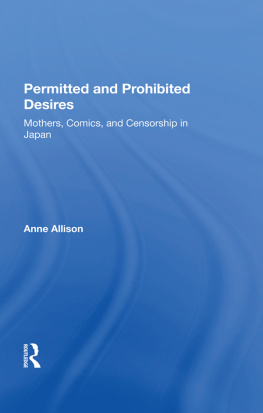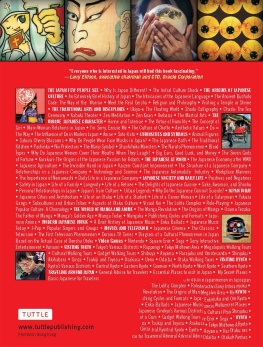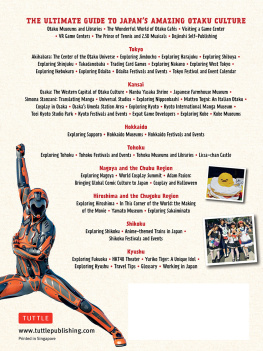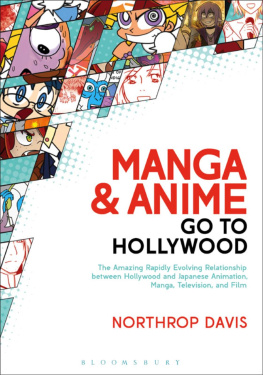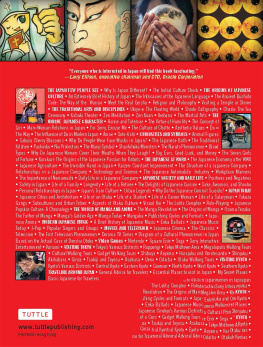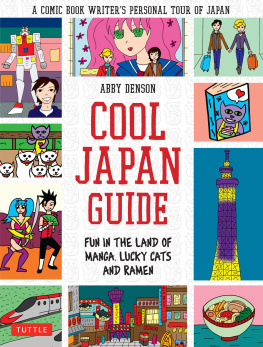A

BOOK
The Philip E. Lilienthal imprint
honors special books
in commemoration of a man whose work
at University of California Press from 1954 to 1979
was marked by dedication to young authors
and to high standards in the field of Asian Studies.
Friends, family, authors, and foundations have together
endowed the Lilienthal Fund, which enables UC Press
to publish under this imprint selected books
in a way that reflects the taste and judgment
of a great and beloved editor.
The costs of publishing this book have been defrayed in part by the Hiromi Arisawa Memorial Awards from the Books on Japan Fund. The awards are financed by The Japan Foundation from generous donations contributed by Japanese individuals and companies.
MILLENNIAL MONSTERS
ASIA: LOCAL STUDIES/GLOBAL THEMES
Jeffrey N. Wasserstrom, Kren Wigen, and Hue-Tam Ho Tai, Editors
1. Bicycle Citizens: The Political World of the Japanese Housewife, by Robin M. LeBlanc
2. The Nanjing Massacre in History and Historiography, edited by Joshua A. Fogel
3. The Country of Memory: Remaking the Past in Late Socialist Vietnam, by Hue-Tam Ho Tai
4. Chinese Femininities/Chinese Masculinities: A Reader, edited by Susan Brownell and Jeffrey N. Wasserstrom
5. Chinese Visions of Family and State, 19151953, by Susan L. Glosser
6. An Artistic Exile: A Life of Feng Zikai (18981975), by Geremie R. Barm
7. Mapping Early Modern Japan: Space, Place, and Culture in the Tokugawa Period, 16031868, by Marcia Yonemoto
8. Republican Beijing: The City and Its Histories, by Madeleine Yue Dong
9. Hygienic Modernity: Meanings of Health and Disease in Treaty-Port China, by Ruth Rogaski
10. Marrow of the Nation: A History of Sport and Physical Culture in Republican China, by Andrew D. Morris
11. Vicarious Language: Gender and Linguistic Modernity in Japan, by Miyako Inoue
12. Japan in Print: Information and Nation in the Early Modern Period, by Mary Elizabeth Berry
13. Millennial Monsters: Japanese Toys and the Global Imagination, by Anne Allison
14. After the Massacre: Commemoration and Consolation in Ha My and My Lai, by Heonik Kwon
Millennial Monsters
Japanese Toys and the Global Imagination
ANNE ALLISON
Foreword by GARY CROSS

University of California Press, one of the most distinguished university presses in the United States, enriches lives around the world by advancing scholarship in the humanities, social sciences, and natural sciences. Its activities are supported by the UC Press Foundation and by philanthropic contributions from individuals and institutions. For more information, visit www.ucpress.edu .
University of California Press
Berkeley and Los Angeles, California
University of California Press, Ltd.
London, England
2006 by The Regents of the University of California
Library of Congress Cataloging-in-Publication Data
Allison, Anne, 1950
Millennial monsters : Japanese toys and the global imagination / Anne Allison ; foreword by Gary Cross.
p. cm.(Asialocal studies/global themes ; 13)
Includes bibliographical references and index.
ISBN 0-520-22148-6 (cloth : alk. paper)ISBN 0-520-24565-2 (pbk. : alk. paper)
1. ToysJapan. 2. GamesJapan. 3. Animated filmsJapan. 4. Video gamesJapan. 5. Consumer goodsJapan. 6. Toy industryJapan. 7. ToysJapanMarketing. 8. Philosophy, Japanese. 9. JapanSocial life and customs. I. Title. II. Series.
GN635.J2A55 2006
688.720952dc22
2005025770
Manufactured in the United States of America
15 14 13 12 11 10 09 08 07 06
10 9 8 7 6 5 4 3 2 1
The paper used in this publication meets the minimum requirements of ANSI/NISO Z39.48-1992 (R 1997) (Permanence of Paper).
To Charlie
Contents
Illustrations
Foreword
GARY CROSS
Those of us who work in the often uncharted jungles of American and European popular and commercial culture are continually encountering the monsters of Japanthose often cute and cool critters that, especially of late, seem to have crashed onto the scene. They make us wonder: Where did they come from? Why have they so captured the imagination of children and adults on a global scale? I have often thought a really informed book about why and how Japanese popular culture has succeeded in becoming (with American pop culture) the leading exporter of fantasy, especially to the young, would go far in explaining both cultural globalization and contemporary childrens commercial culture. In these covers, we have that book.
Of course, much of Japanese fantasy in anime, comic books, video games, and toys has been influenced by the West. For the first sixty years of the twentieth century, the Japanese playthings industry was indebted to German and especially American innovation. Linkages between Japanese and American childrens consumption were well established by the 1930s, when Louis Marx, the famous American manufacturer of windup Popeyes and racist Alabama Coon Jiggers, outsourced production to Japan. After World War II, Japan became an exporter of robots and space toys made of tin cans to an American market eager for science-fiction and space themes: Japanese spaceships looked like hastily recycled tanks and other war toys, and the toy figures looked alien to Westerners because Japanese toy makers could not afford to license images of movie and TV icons like Flash Gordon and Space Cadet.
By the late 1960s, however, Japan was producing quality Datsuns and other cars for export, and it exploited the development of transistor and digital technology to drive American and European manufacturers of TVs, radios, and stereos out of business. Still, few in the West seemed to take Japanese popular culture seriously. Until recently, the memory of cheesy Godzilla movies shown for laughs on late-night television seemed to epitomize Japanese popular culture. The revolutionary Walkman was widely embraced, but not Japanese music. Japan got its own Disneyland in 1983, a decade before Europe, but, while it had its own character, Tokyo Disneyland was still derivative. Yet all this began to change noticeably in the 1990s with the coming of Mighty Morphin Power Rangers, Sailor Moon, tamagotchi, and Pokmon, along with anime movies, video games, and much else.
One factor behind this transformation was the fact that the business models of Japanese manufacturers of playthings were consistent with American models of merchandising and manufacturing fantasy; they did not stick with the more parent-friendly approach of European toymakers. As early as the 1920s, toy and childrens-book producers had learned the art of sliding characters and stories across platforms of fantasy. While British and German doll and toy makers stuck to miniaturizing adult life (e.g., through dolls houses and vehicles) and usually maintained a didactic tone, Japanese manufacturers were influenced by American innovation in childrens fantasy by cross-marketing characters from comic books and illustrated stories in the form of dolls, toys, and games. Tying toys and dolls to childrens fantasy narratives was key to Disneys success in the 1930s, when Mickey Mouse became a global friend via sand pails, toothbrushes, and comic books as well as through Saturday-morning gatherings of Mickey Mouse Clubs, which met to watch his cartoons in neighborhood cinemas. The merchandising of
Next page

